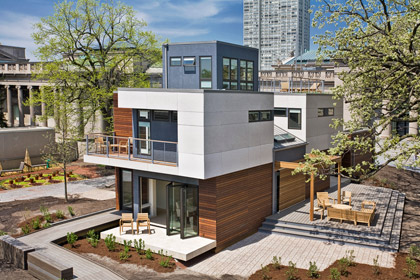Back around 2006, when the American Dream of home ownership was still intact and green building was officially transferred from the domain of hippies to yuppies, folks got very excited about prefab. Here in New York City, my friends and I felt our second-home prayers had been answered (not that we could afford a first home): we’d buy a plot of land in the country and plop down a bunch of panelized, pre-fabricated high modern houses for well less than $100,000 each–something stylish and healthy and affordable that would re-create the bungalow colony model. Online message boards like FabPreFab exploded with instant architecture and a generation of excited potential buyers for it: the weeHouse, the NowHouse, the b-line.
 Michelle KaufmanPerhaps the most celebrated of those creations was the Glidehouse, Michelle Kaufman’s factory-built, site-assembled energy- and water-efficient home that channeled the aesthetic of the Eamses and the systems of an Earthship. Though it ended up on fewer plots than anyone following the prefab frenzy would have thought–her firm has manufactured and sold about 40 models since 2004–the Glidehouse did land at a green building exhibit inside the National Building Museum and firmly in the hearts of architecture aficionados.
Michelle KaufmanPerhaps the most celebrated of those creations was the Glidehouse, Michelle Kaufman’s factory-built, site-assembled energy- and water-efficient home that channeled the aesthetic of the Eamses and the systems of an Earthship. Though it ended up on fewer plots than anyone following the prefab frenzy would have thought–her firm has manufactured and sold about 40 models since 2004–the Glidehouse did land at a green building exhibit inside the National Building Museum and firmly in the hearts of architecture aficionados.
So many were shocked last week at the announcement that Michelle Kaufman Designs would close–a victim, she says, of the recession: lending problems, manufacturing issues, and just not enough demand. (The FabPreFab boards were silent on the matter; they haven’t been updated much since 2007, the beginning of the end of the real estate madness.) No one was more shocked than Kaufman herself. “I thought we had gotten lean and strong,” she told me when I caught up with her this week. “It took me by surprise.”
Part of the problem, she says, was scale. The affordability part of prefab is rooted in mass production; you need to have big orders, even if they’re from different buyers, to make manufacturing financially viable. You can’t do prefab and one-off housing, both.
But Kaufman is optimistic, despite shutting her doors; the recession, it turns out, will give her designs a second chance. “There’s another path, and in this economy it might be a more successful one,” she says. That path is multi-family housing — and it involves working with developers. Yes, the very creatures who were cut out of the previous prefab dream, and with good reason; but now they’re being forced to reform. “In the past 15 to 30 years, developers could build whatever crap they wanted and people were buying it,” Kaufman says. But the weak economy is making consumers more discerning, so developers “have to be more thoughtful about what they build.”
So Kaufman, in partnership with two different sets of developers, is melding prefab with multi-family, building in the demand that failed to materialize last time. She’s creating two communities-in-the-making, one in Denver with Urban Ventures LLC and another with Ponte Vista at San Pedro, near Los Angeles. Both will have multiples of Kaufman’s mkSolaire townhouse (also a museum piece — you can see it on view at the Museum of Science and Industry in Chicago right now), a structure with open, loft-like spaces and many of the Glidehouse’s features: energy- and water-saving fixtures, natural air circulation and daylighting, mold-resistant ingredients.
 The mkSolaire will populate Kaufman’s multi-family developments.Michelle Kaufman DesignsDesigning communities, she says, is different — better, in fact — than designing houses. Kaufman now considers much more than an individual building. She thinks of how units will piece together and what goes between them, as well as who lives in them. “I’m designing for diversity,” she says, so the communities will appeal to people of different ages and economic backgrounds, suitable for older folks interested in aging-in-place, for young families, for single folks buying starter homes. And these won’t be merely collections of buildings but communities, with group gardens and communal endeavors such as bike sharing, car sharing, and even garden tool sharing.
The mkSolaire will populate Kaufman’s multi-family developments.Michelle Kaufman DesignsDesigning communities, she says, is different — better, in fact — than designing houses. Kaufman now considers much more than an individual building. She thinks of how units will piece together and what goes between them, as well as who lives in them. “I’m designing for diversity,” she says, so the communities will appeal to people of different ages and economic backgrounds, suitable for older folks interested in aging-in-place, for young families, for single folks buying starter homes. And these won’t be merely collections of buildings but communities, with group gardens and communal endeavors such as bike sharing, car sharing, and even garden tool sharing.
Pricing is still unknown, though both communities should have a mixture of market-rate and affordable. Construction costs, Kaufman hopes, should be less than $160 per square foot, not including the land.
Essentially, she is making the bungalow colonies that my friends and I have been dreaming of for the last few years. One reason more such developments aren’t readily available is the firmly entrenched zoning that makes it hard to cluster small homes and maintain shared, commonly owned spaces. Many municipalities want houses on a minimum of an acre or so, or have minimum house-size standards. But Kaufman says that hasn’t been a problem for her in these endeavors. The real problem, she says, is getting mortgages for the homeowners themselves. “Lending remains a big hurdle for them,” she says, “but hopefully that will change.”




